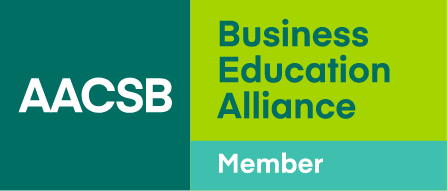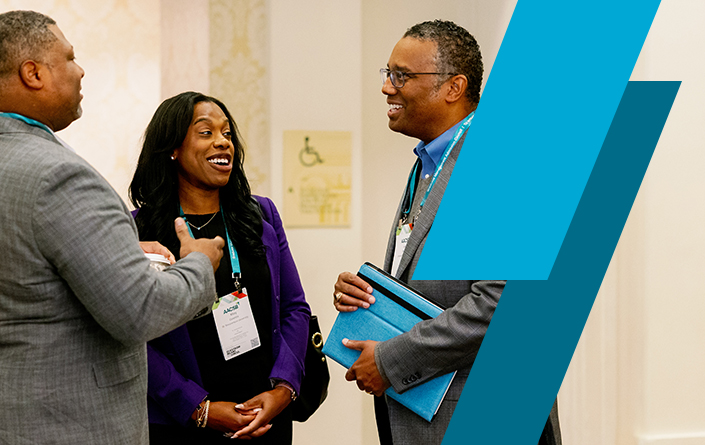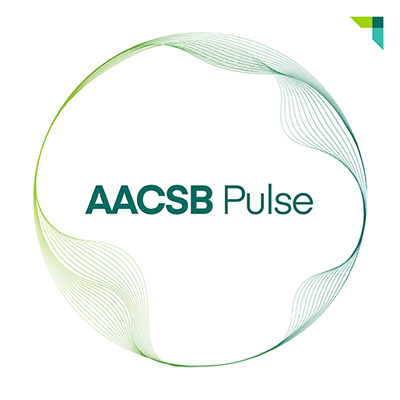Governance Remodeling Project
A Strategic Update for Members
AACSB has undertaken a comprehensive governance assessment to ensure its structure remains responsive, aligned with the needs of its global membership, and future-focused. AACSB's Board of Directors has engaged in meaningful consultation with stakeholders across regions—conducting leadership surveys, benchmarking, and a multi-day summit to explore and evaluate new governance models. We encourage you to review the updated and member approved bylaws presented below.
Notice of Member Vote
We are pleased to share that the amended and restated bylaws have been approved by AACSB’s membership at the Member Meeting held on October 20, 2025, in conjunction with the Deans Conference in Toronto.
AACSB will transition to the new governance model effective July 1, 2026. The updated bylaws and governance structure reflects your voices: a comprehensive 18-month review of AACSB's governance that drew on board sessions, a two-day remodeling summit with regional representatives, data collection and benchmarking, and five regional membership town halls.
Next, AACSB will conduct a comprehensive review of committees, governing practices, and policy governance to ensure they are in alignment with the new governance model.
Why the Change?
- A comprehensive governance review is critical as it impacts how the board informs and directs the activities that achieve an organization's objectives.
- It has been several decades since a full review was conducted, and the current bylaws are rooted in a much smaller, US-based organization.
- Updated bylaws need to reflect AACSB as a global organization with increased engagement between the board and stakeholders.
- Improve decision-making, transparency, and accountability with better communication to strengthen integrity and trust.
- In February 2024, the Board charged the Articles and Bylaws committee with conducting a comprehensive review. Five member town halls were conducted, with strong overall support of the proposed changes.
Key Changes
- More transparent and accountable decision-making with a well-defined, competency-based board of 13-17 directors.
- Modern and cost-effective structure with right-sized board and governance activities.
- Stronger regional voices with the nominating committee composition to include regional advisory council chairs.
- New ways to contribute through focused task forces and advisory roles.
- Global, more resilient structure for long-term success, enabling the board to create committees based on the organization's needs.
- Modernized member voting, quorum, and meeting rules, including clearer proxy use and more flexible business meeting requirements.
Full List of Amendments and Restatements
- The Amended and Restated Bylaws open with a section of Defined Terms for clarity and transparency.
- Board of Directors reduced in size to 13-17 board members (currently up to 30).
- Governance structure to be strengthened through a newly formed Governance Committee and expanded Audit and Risk Committee.
- Standards for Business Education to be maintained by a new Global Standards Committee, with the new Global Accreditation Committee overseeing accreditation policies.
- The Nominating Committee is appointed by the Board, and includes the chairs or designees of each of the regional advisory councils.
- The Nominating Committee shall nominate candidates for Directors to be elected by the Members in an uncontested election; currently elections are contested.
- Clearer officer vacancy policies, providing a strong succession framework.
- The Board may create standing and ad hoc committees subject to the provisions of the policy governance manual.
- Clearer language around the Accreditation Council, its members, and voting rights.
- Members may designate a proxy in the case of a member vote. A proxy must be an individual serving in a bona fide leadership position within the same member organization.
- Member meeting notice strengthened; at least 60 days for place/date/time and at least 20 days for purpose. No standing annual business meeting requirement; instead, the Board may call Member/Accreditation Council meetings from time to time.
- The Amended and Restated Bylaws create clearer guidance on indemnification of Board members and other AACSB volunteers consistent with modern governance.
What Hasn't Changed
- AACSB's commitment to its mission and values.
- Who AACSB’s Members are at core. Members are Organizations—Educational and Business—represented by an official representative; each Member has one vote on matters put to Members.
- Board-centered organizational oversight. The Board remains the overarching policy-making body of AACSB, responsible for overseeing the organization, supported by officers, committees, and staff.
- Globally engaged board that is reflective of the character of the membership, striving for efficient and effective decision-making.
- The four Board officers: Chair, Vice Chair-Chair Elect, Secretary-Treasurer, and President and CEO.
- Board members may serve up to two consecutive terms, with extension of Board service permitted for service as an Officer.
- Educational member dues remain subject to member approval.
- Accredited Members have final authority for approval of the standards for business education and accreditation, with accounting standards voted on only by Members holding acounting accreditation.
- Revisions to the Bylaws to be approved by the Members.
Why This Matters to You
This project goes beyond structural change—it’s about building a governance system that better supports an agile, effective, and member-responsive association. The proposed model is designed to:
Strengthen Board Composition
to reflect AACSB’s diverse membership by geography and institution type, while emphasizing relevant skills and experience.
Reduce Board Size
to improve agility and introduce a competency-based nomination process.
Improve Transparency and Communication
between the board, Regional Advisory Councils, and the broader membership.
Restructure board committees
to align with evolving needs, including newly established global committees for accreditation oversight.
Streamline Decision-Making
while broadening opportunities for member input and leadership.
Align Governance With AACSB’s Mission and Strategic Direction
and the changing needs of business education globally.
Town Hall Conversations
AACSB hosted a series of member town halls to share a draft governance model.
Recorded Sessions:
AACSB members were invited to join any of the listed sessions. If a session has passed, you can still register to access the recording.
Asia Pacific: May 27, 7:00 pm ET, 7:00 am SGT (This session was not recorded. Please select another session to view a recording.)
Latin America: May 29, 2:00 pm ET
North America: June 16, 12:00 pm ET
Middle East and Africa: June 17, 1:00 pm ET, 8:00 pm EEST
Europe: June 23, 9:00am ET, 3:00 pm CEST
Frequently Asked Questions
Why was the governance remodeling project undertaken?
AACSB’s current governance model was established when the organization was a fifth of its current size and still incorporated as the American Association of Collegiate Schools of Business. In recognizing the need for a more agile, transparent, and globally inclusive governance model, the AACSB Board of Directors launched this project to modernize its governance structure. The project was designed to ensure that AACSB’s future governance remains responsive to the needs of its members around the world.
Will there be a redlined version of the bylaws?
There will not be a redlined version of the bylaws as they have been fully restated. The new version modernizes and streamlines the document to reflect current association governance best practices, making a comparison against the former version impractical. The new version of the bylaws are available for your review above.
What are the main goals of the remodeling project?
The project is designed to:
- Enhance inclusivity and global engagement.
- Increase the agility and effectiveness of decision-making.
- Align governance structures with AACSB’s strategic priorities.
- Ensure transparency and accountability in governance.
- Strengthen the role of member engagement in strategic oversight.
What project governance has been established for the project?
The governance remodeling project is led by leadership from the Board of Directors, including the Board Chair, Vice Chair-Chair Elect, Immediate Past Chair, the Articles and Bylaws Committee, and President & CEO of AACSB. The project is facilitated by an independent governance consultant, Tecker International.
How were members involved in shaping this new model?
The project included:
- Survey of AACSB stakeholder leadership and regional representatives to provide input on governance structure and process.
- A global governance summit with AACSB board members, invited stakeholders from each global region, and staff.
- Benchmarking with multiple governance models.
- Ongoing input from regional groups.
- A multi-month consultation and refinement process.
- Member engagement through several town hall sessions and feedback mechanisms.
What are the key changes from the previous governance model?
Board of Directors:
- Smaller board size: 13–17 members, reduced from the current size of up to 30 members.
- Balanced representation: Includes both accredited and non-accredited educational institutions, and business members.
- Competency-based nominations: Emphasis on experience, skills, and inclusivity.
- Accreditation decisions: Transfer responsibility for accreditation ratifications to the new Global Accreditation Committee.
- Board oversight of standards and accreditation: A defined reporting mechanism to the board from the Global Standards Committee and the Global Accreditation Committee.
- Nominating Committee: Regional advisory council chairs to participate directly in board nominations. Updated nomination and selection process.
- Audit Committee: Revised to Audit & Risk Committee, with an expanded scope for improved risk oversight.
- Articles & Bylaws Committee: Reconstituted as the Governance Committee with the responsibility of advising the board on good organizational governance practices and to ensure board effectiveness.
- Innovation Committee retired: The Board may establish timely Emerging Practices Task Forces in response to emerging issues and needs, enhancing agility and effectiveness.
- Strengthened global presence: New North America Advisory Council added; broaden engagement of African constituency through the transition of the Middle East and North Africa Advisory Council to the Middle East and Africa Advisory Council.
- Deeper communication and engagement with the board: In addition to the Regional Advisory Council Chairs joining the Nominating Committee, communication pathways will be established for sharing input and feedback with the board.
- NEW Global Standards Committee (GSC): Reviews and updates Global Standards for Business Education and Accounting Accreditation Standards every five years, with annual technical edits.
- New Global Accreditation Committee (GAC): Combines the Business Accreditation Policy Committee (BAPC) and Accounting Accreditation Policy Committee (AAPC) for better collaboration and coordination. Oversees application of business and accounting standards, maintains accreditation policies, and ratifies accreditation committee decisions.
Will this affect accreditation processes?
There will be no changes to the accreditation standards or processes in 2025–2026. The governance updates will go into effect in 2026-27, primarily regarding oversight and reporting structures. Once established, standards and accreditation oversight will be provided by the newly structured GAC and GSC. In addition, accreditation ratification decisions will be transferred from the board of directors to the GAC.
What is not changing?
While AACSB is making meaningful improvements to its governance structure, several foundational elements will remain unchanged:
- Continued commitment to AACSB’s mission and core values.
- Ongoing emphasis on a “Members First” mindset across all organizational activities.
- A globally engaged board that reflects the character of AACSB’s membership.
- Preservation of the structure and responsibilities of board leadership roles.
- Continued operation of essential standing committees, including the Executive Committee and the Finance and Investment Committee.
- The Accreditation Council (accredited members) remains responsible for maintaining and overseeing global accreditation standards.
- Members retain their right to vote on changes to bylaws and the approval of membership dues.
- No changes to the Articles of Incorporation.
What are the benefits of this new governance model for AACSB members?
Members can expect:
- Stronger regional representation through deeper engagement with Regional Advisory Councils.
- Greater access to leadership opportunities via competency-based nomination processes.
- Increased clarity and transparency around governance processes and decision-making.
- More efficient communication channels between the board, regional bodies, and the wider membership.
- New opportunities to engage through issue-based task forces and advisory roles.
What are the benefits for AACSB as an organization?
For AACSB, the new governance model:
- Aligns governance with its global mission and strategic goals.
- Enhances the board’s ability to respond swiftly to emerging issues.
- Modernizes the structure to ensure long-term organizational resilience.
- Increases the capacity for innovation through focused, temporary task forces.
- Strengthens the feedback loop between members and leadership.
- Reduces the cost related to the board and governance activities
What are the steps in the governance remodeling process?
- May–June 2025: Member town halls to present the model and gather input.
- June 2025: Tecker International will synthesize feedback from town halls.
- July-August 2025: Draft Bylaws revisions to be completed.
- September–October 2025: Final governance model, Bylaws changes to be shared with and approved by the board in September, and members at 2025 Deans Conference.
- 2025–2026 onward: NO impact in 2025-26. Transition and implementation will begin in 2026-2027.






